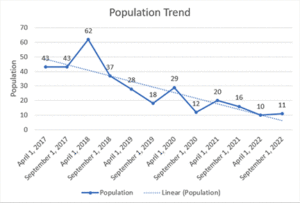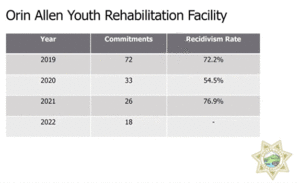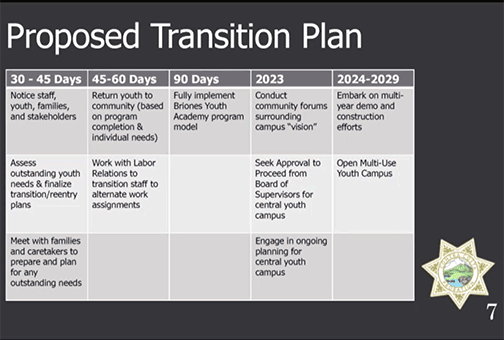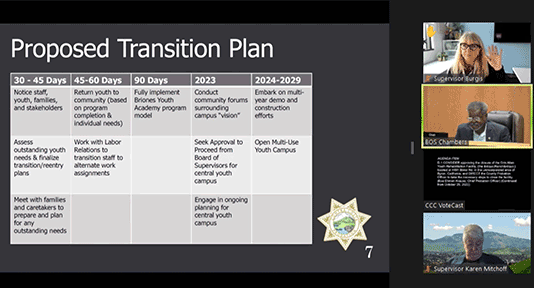On Tuesday, the Contra Costa County Board of Supervisors voted to close the Orin Allen Youth Rehabilitation Facility in Byron.
The closure will occur sometime in the next 60-90 days and which includes the transition of 36 staff members from Orin Allen to new positions within the county probation department.
The January 2023 closure was supported by Supervisors Candace Andersen, Diane Burgis and Karen Mitchoff. Supervisor John Gioia and Supervisor Glover voted against the plan citing they wanted the closure to occur in March of 2023.
The operating expenses for Orin Allen Youth Rehabilitation Facility (OAYRF) total approximately $6,546,500 for fiscal year 2022-23. The latest estimate on deferred maintenance needs is $5.4 million based on the facility condition assessment report completed by Gordian in 2021. Additionally, the average annual maintenance for the facility is $595,579.
As designed, OAYRF is considered minimum security, and is intended to serve low to moderate risk youth. This facility has a Board of State and Community Corrections rated bed capacity of 100.
 During the presentation to the Board, Chief Probation Officer Esa Ehmen-Krause highlighted the Briones Youth Academy youth paths and pathways they take with juveniles (see graphic). She also noted the population decrease at the facility citing reform efforts, increased advocacy or various strategies implemented locally.
During the presentation to the Board, Chief Probation Officer Esa Ehmen-Krause highlighted the Briones Youth Academy youth paths and pathways they take with juveniles (see graphic). She also noted the population decrease at the facility citing reform efforts, increased advocacy or various strategies implemented locally.
She believed it was the “significant acknowledgement that low and moderate at-risk youth don’t belong in an incarcerated environment” away from their community.
 “Overall, the population at Orin Allen continues to decrease,” said Ehmen-Krause. “To date, since 2019, there have only been 149 youth committed to Orin Allen. One might try and argue COVID-19 artificially deflated the population, however, I’d like to point out the count in Sept. 2019 prior to the pandemic was 18, and the count at the height of the pandemic was slightly higher at 20.”
“Overall, the population at Orin Allen continues to decrease,” said Ehmen-Krause. “To date, since 2019, there have only been 149 youth committed to Orin Allen. One might try and argue COVID-19 artificially deflated the population, however, I’d like to point out the count in Sept. 2019 prior to the pandemic was 18, and the count at the height of the pandemic was slightly higher at 20.”
Population Levels:
- April 1, 2018 – 62
- April 1, 2020 – 29
- April 1, 2022 – 10
- Sept. 1, 2022 – 11
 Ehmen-Krause stated she had been consistently advocating for the County to close Orin Allen over the past two-years.
Ehmen-Krause stated she had been consistently advocating for the County to close Orin Allen over the past two-years.
She also called the outcomes of the program “abysmal” with data showing the recidivism rates at 76.9% in 2021 and 54.5% in 2020.
“Of the 149 commitments since January 2019, this program has an average recidivism rate of 67%,” explained Ehmen-Krause. “This data makes it very clear we need to do something different.”
Supervisor Burgis asked given the recidivism number, what is a realistic goal?
Ehmen-Krause said programs vary but in the 30-40% range would be average noting she has never seen anything below 20%.
Supervisor Glover called the recidivism numbers “disturbing” saying the numbers were very surprising to him.
Ehmen-Krause continued to urged the board to approve the closure recommendation which would transition the youth back to the community—noting the closure by January 2023 is a soft projection and they are prepared to be as nimble as possible.
“The county does have urgent and emerging staffing needs resulting from the closure of DJJ and prolonging the closure will have impacts and consequences to other programs and delay full implementation of both the secure tract and community paths,” stated Ehmen-Krause. “The department has more than tripled our investment in community providers in the past 2.5 years and that is only on the juvenile side. We probably have tripled it if we have included all our adults as well.”
She called it an “opportunity” to do something different for the youth in Contra Costa County.
Glover questioned the number of beds in use as currently they have 12 beds being used but anticipated just 4 beds in use by the end of the year.
“Is that because we are no longer referring people to the ranch?” asked Glover.
Ehmen-Krause acknowledged they did suspend screenings based on the outcome of the board of supervisors saying they didn’t want to increase their count having “temporary suspended” it.
“Should the board not support closure, we would re-institute screenings, but we didn’t have any young people come through who would have been screened,” said Ehmen-Krause
Supervisor Andersen shared the sub-committees have been involved, which include the Contra Costa District Attorney’s Office and Public Defenders, saying she was concerned when they say they were “surprised by this” as this has been a conversation for several years.
Andersen further shared many people have reached out stating they are going to expand juvenile hall, but the plan was to actually reduce juvenile hall. She requested Ehmen-Krause to further explain.
Ehmen-Krause explained youth who would have been sent to the Byron Ranch would now be going to a “community path” and not to juvenile hall. She also explained if there was an issue at the youths home, they would be screened for placement.
“Admittingly, its much easier to send a youth to the ranch because you don’t have to go through the same approval process but really if you are looking at it as a case or family issue that is a young person we should be screening for a short-term residential treatment program, but an incarcerated environment,” stated Ehmen-Kraus.
Supervisor Gioia stated there was no price to doing it right versus timing the closure based on finances. He asked about potentially closing in March of 2023 versus January 2023.
Ehmen-Krause stated it wasn’t a “money issue” saying they did not anticipate a max capacity at launch and called it a “bodies issue” and no way to grow scale of the program without the staff for the program—this would make the community path an alternative to Orin Allen.
“The outcomes for the ranch are pretty abysmal so I would also say ethically when I saw the outcomes I struggled even sending any more kids to the ranch,” stated Ehmen-Krause. “You never want to know a program you are running is failing young people. We are going to watch the outcomes from the community path very closely but unfortunately, we can’t grow one to scale with the programing we want to offer without the staff from the ranch.”
In response to Gioia, she said they would not be able to fully implement the community path if they wait until March.
Supervisor Burgis stated based on letters she has received there was a misunderstanding from the public about where these youths will go. She asked Ehmen-Krause to again confirm these youths will not be placed in juvenile hall.
Ehmen-Krause confirmed the youth currently at Orin Allen would be placed on the community path and if going home was not an option, they have other options for placement such as family stabilization and family finding options—they also can offer support services to families for stabilization.
She acknowledged some of the confusion came from one of their earliest proposals in early 2020 where they did propose closing down the ranch and move the juveniles to the Tamalpais Unit – but heard the concerns and pivoted to develop a community alternative.
Gioia asked what was the opinion of the presiding judge was on the proposal. Ehmen-Krause responded the judge has been supportive once they presented an outline of the program model.
Andersen stated while there was some disagreement on the timeline, she called it a great move.
“We want those who commit an offense to be back in their community if it’s a low-level offense where we can provide them those services and help them stay within their community,” said Andersen. “This is an alternative to incarceration that I think is a great move as we as a community re-imagine youth justice.”
 After Public Comments, the Board of Supervisors discussed the closure.
After Public Comments, the Board of Supervisors discussed the closure.
Andersen stated the whole point was to move people out of The Ranch into the community pathway program so there would be no need for the ranch in the future.
Ehmen-Krause shared the court could always place electronic monitoring if public safety was a concern. With more staff, they could handle more youth so they have a bigger program available. She also respected concern about launching the program quickly, but said they have had successful home programs in the past—but went away due to resource issues.
“Right now, the immediate needs is well-trained staff,” said Ehmen-Krause.
Andersen stated one of the concerns stated was they had not had community input but noted they had community input through their committee meetings and anticipate bringing in additional community input.
Ehmen-Krause explained through the Juvenile Justice Council is over the past two-years they made two sub-committees which they aimed for community engagement along with robust youth feedback. She also noted various community forums which contributed to the development of the program such as mental health, education and safety issues.
Supervisor Karen Mitchoff called this “not a new idea and just hasn’t come up” saying in previous presentation they had listed the types of crimes youth at Orin Allen were charged with. She asked what types of cases for those youths that are out there.
Ehmen-Krause explained she didn’t have specific cases, but said they had a lot of property crimes. weapon offenses.
“I have a different view of the juvenile system, I think it is a valuable system,” stated Mitchoff. “I personally don’t know how we would ever close a juvenile hall because unfortunate there will always be situations where young people, these are not children, you can classify a 16 year-old as a child, but they are teenagers and young adults, I find it interesting that a lot of advocates, and I don’t disagree with this fact, that the brain of a teenager is not formally developed and therefor they should not be charged in the adult system even if they are a teenager because of the lack of a fully formed frontal lobe. But yet, the same advocates that these individuals should be part of the conversation and discussion.”
Mitchoff added that she believed they needed a “holistic approach” to solving this but today’s item was just the transitioning over a period of time to the community path for people out at Orin Allen which she would support the recommendation.
Supervisor Gioia urged the board to move the closure to March 2023 and that this was being framed as community model being “great” but not everyone will be in that.
“Let’s be ready for when the ranch is going to close so we can accommodate them so they don’t get lost in the system so they don’t end up somewhere more institutional than they otherwise would have ended up,” stated Gioia.
Andersen disagreed and made the motion to close the ranch and urged more community based programs.
“Until we really start moving forward full steam ahead, we are not going to know what the deficiencies are in this. We have a very good program that can expand to capacity. We do have alternate locations for youth to go if their home is not appropriate,” said Andersen. “What I like about this program is it is individualized for each and every youth depending on circumstances that bring them before probation and a judge.”
She also acknowledged most of the work being done is now focused on prevention and what they are doing to prevent a youth from getting to this point where we have a youth who is brought into the system—including more family assistance and support with juveniles.
“Hopefully we are going to be breaking some familiar cycles,” said Andersen. “It’s time to rip off the band-aid and move forward and not keep talking about it because it doesn’t make sense to keep both programs running in parallel. You don’t have the staffing and don’t want the youth out there when they can be back home in their own communities.”
Gioia, based on the Juvenile Justice Committee Report, offered a substitute motion that they extended this until March. It was seconded by Glover.
Glover shared that people need to understand that Orin Allen was a person and someone he knew who was a voice with a philosophy that was not to introduce young people, who were deemed “problem children”, into the institution of the criminal justice system.
“Orin’s philosophy was not to have youth, low level offenders, put up into the institution that would incarcerate folks who could create behavior that would be much more tied to our criminal justice system, but an opportunity to change lives,” explained Glover noting some great programs were put in place. “One of the most popular was the read to live program where individuals from Rossmoor out to teach young people how to read so they could compete in the classroom and not find themselves in a place where they acted out.”
Glover said he believe Orin would not have a problem with the community pathways system, but agreed that the juvenile justice committee was looking at ensuring the process was in place prior to the closure—which is why he supported the motion in an effort to give more time to be a part of the process and in place.
The board voted against the substitute motion to delay closure until end of March in a 2-3 vote with Andersen, Burgis and Mitchoff opposed with Gioia and Glover supported the motion.
The board voted 3-2 to approve closure of Orin Allen Youth Rehabilitation Facility in next 60-90 days with Andersen, Burgis and Mitchoff in favor. Gioia and Glover opposed.
Note
The Briones Youth Academy, Community Path allows youth the opportunity to engage in the same comprehensive evidence-based programs and services that they would have received at Orin Allen, while remaining at home, in their communities. This minimizes the disruption and impact on youth and families, allowing them to focus on rehabilitative services. The Probation Department, in partnership with community based providers, would see youth seven days a week, and will transport youth to regional locations, three nights a week for cognitive behavioral group programming, as well as provide access to the same recreational program options, such as sailing and hiking trips, on the weekends. Intensive, home-based family therapy, and the ability to serve girls, are two additional advantages of the BYA, Community Path that are unable to be replicated at the Orin Allen Youth Rehabilitation Facility.

